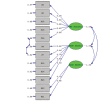Validity and Reliability of the Neonatal Palliative Care Attitude Scale in Turkey
- PMID: 34263240
- PMCID: PMC8245023
- DOI: 10.5152/FNJN.2021.20041
Validity and Reliability of the Neonatal Palliative Care Attitude Scale in Turkey
Abstract
Aim: This study aimed to establish the validity and reliability of the Neonatal Palliative Care Attitude Scale in Turkey.
Method: This methodological study was conducted between December, 2014, and July, 2017, in the neonatal intensive care unit of 4 hospitals (2 public, 1 university, and 1 private hospital) in the center of a city in eastern Turkey. The study population consisted of all the nurses of the hospitals. No sampling was performed, and the sample consisted of 145 nurses who agreed to participate in the study. The 26-item Neonatal Palliative Care Attitude Scale developed by Kain et al. (2009) was translated into Turkish and then back-translated into English for to determine the validity for Turkey. Experts were consulted to determine the validity of the content. Cronbach's alpha coefficient, test-retest reliability, and item-total correlation were used for reliability. Exploratory and confirmatory factor analyses were used for validity.
Results: Content validity index ranged from .8 to 1.0. The Kaiser-Meyer-Olkin measure of sampling adequacy was .934, for which the Bartlett's test of sphericity was χ2 = 415.127, p = .000. According to the principal component analysis, the Neonatal Palliative Care Attitude Scale in Turkey. had 3 subscales as did the original Neonatal Palliative Care Attitude Scale. The items had factor loadings greater than .40, and the factors accounted for 55.51% of the total variance. The subscales "organization," "resources," and "clinician" had a Cronbach's alpha of .692, .710, and .680, respectively.
Conclusion: The Neonatal Palliative Care Attitude Scale in Turkey. has a structure similar to that of the original Neonatal Palliative Care Attitude Scale and has high validity and reliability. It is, therefore, a valid and reliable instrument that can be used to identify nurses' attitudes toward neonatal palliative care.
Keywords: Attitude; neonate; nursing; palliative care; validity-reliability.
Copyright © 2021 Florence Nightingale Journal of Nursing.
Conflict of interest statement
Conflict of Interest: The authors have no conflicts of interest to declare.
Figures
Similar articles
-
Evaluation of reliability and validity regarding the Chinese version of Critical Cultural Competence Scale for clinical nurses.Zhong Nan Da Xue Xue Bao Yi Xue Ban. 2022 Oct 28;47(10):1425-1434. doi: 10.11817/j.issn.1672-7347.2022.210695. Zhong Nan Da Xue Xue Bao Yi Xue Ban. 2022. PMID: 36411694 Free PMC article. Clinical Trial. Chinese, English.
-
Development and psychometric testing of the Pediatric Atraumatic Care Attitude Scale (PACAS) in pediatric nurses.J Pediatr Nurs. 2024 Nov-Dec;79:e31-e37. doi: 10.1016/j.pedn.2024.09.015. Epub 2024 Sep 24. J Pediatr Nurs. 2024. PMID: 39322500
-
Developing an instrument to measure nurses' attitudes towards nursing students during clinical practice: A quantitative study.Nurse Educ Today. 2025 Feb;145:106488. doi: 10.1016/j.nedt.2024.106488. Epub 2024 Nov 12. Nurse Educ Today. 2025. PMID: 39556897
-
Food-related quality of life in inflammatory bowel disease: measuring the validity and reliability of the Turkish version of FR-QOL-29.Health Qual Life Outcomes. 2022 Jul 5;20(1):103. doi: 10.1186/s12955-022-02014-9. Health Qual Life Outcomes. 2022. PMID: 35790989 Free PMC article. Review.
-
Psychometric evaluation of the patient perspective on care and rehabilitation scale in geriatric patients.Arch Gerontol Geriatr. 2019 Mar-Apr;81:84-90. doi: 10.1016/j.archger.2018.11.013. Epub 2018 Dec 1. Arch Gerontol Geriatr. 2019. PMID: 30529761 Review.
Cited by
-
Development of the Simplified Chinese version of neonatal palliative care attitude scale.Front Pediatr. 2022 Sep 27;10:962420. doi: 10.3389/fped.2022.962420. eCollection 2022. Front Pediatr. 2022. PMID: 36238602 Free PMC article.
References
-
- Ahmedzai SH, Costa A, Blengini C, Bosch A, Sanz-Ortiz J, Ventafridda V, Verhagen SC International working group convened by the European School of Oncology. A new international framework for palliative care. European Journal of Cancer. 2004;40(15):2192–2200. doi: 10.1016/j.ejca.2004.06.009. - DOI - PubMed
-
- Akgül A, editor. Tıbbi Araştırmalarda istatistiksel analiz teknikleri. SPSS uygulamaları. [Statistical anlaysis techniques in medical research, SPSS applications]. Baskı. Ankara, Turkey: Emek Ofset; 2005. p. 3.
-
- Büyüköztürk, Ş, editor. Veri analizi el kitabı. Vol. 8. [Data analysis handbook]. Baskı. Ankara, Turkey: Pegem Ak Yayıncılık; 2007. pp. 167–182.
-
- Cam M, Baysan Arabacı L. Tutum ölçeği hazırlamada nitel ve nicel adımlar. [Qualitative and quantitative steps on attitude scale construction]. Hemşirelikte Araştırma Geliştirme Dergisi. 2010;12(2):59–71.
LinkOut - more resources
Full Text Sources

